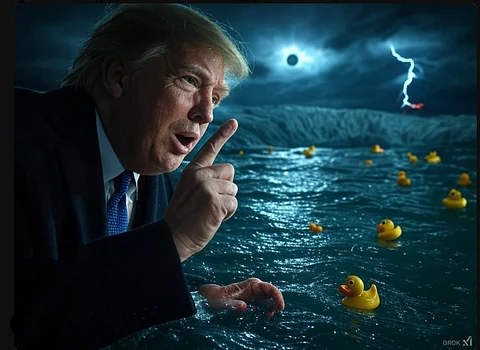

Forget critical minerals.
The real reason US strongman Donald Trump wants to annex the Great White North may be far more elemental, and essential: Water. And Canada has about a fifth of the fresh water on the planet.
The issue has become top of mind because a 60-year old treaty governing water sharing in the Columbia River basin has quietly come up for renewal even as the US strongman threatens punishing tariffs on Canada. Ottawa tried to renegotiate the document, first ratified in 1964, in December hoping to get it signed and sealed before Trump was re-elected.
Now it’s too late, especially after the fires in LA.
“You have millions of gallons of water pouring down from the north with the snow caps in Canada, and all pouring down and they have essentially a very large faucet,” Trump said during the election campaign in September, referring to the Columbia River.
“You turn the faucet and it takes one day to turn it, and it’s massive, it’s as big as the wall of that building right there behind you. You turn that, and all of that water aimlessly goes into the Pacific, and if they turned it back, all of that water would come right down here and right into Los Angeles.”
For students of Canadian history, the Columbia River’s headwaters originate near Cranbook on the western slopes of the Rocky Mountains. David Thompson crossed Athabasca Pass in the winter of 1811 — another period of conflict with the Americans — ultimately opening a 2,000 kilometre trade route to the Pacific Ocean.
Today 470 dams provide about 40% of the US’ hydroelectric power — and half of British Columbia’s — according to the Energy Information Administration (EIA). In dry years, BC is obligated to release water from its own reservoirs to maintain river levels as it crosses into Oregon and Washington state.
The treaty has no end date but either country can unilaterally terminate it from September 2024 onwards provided that at least 10 years notice is given. Already, observers on this side of the border are calling for Canada to unilaterally withdraw to spite the Americans.
Trump’s past comments suggest that, in his view, Canada’s water is not just a resource, it’s a strategic asset that the US could try to access through trade pressure, legal loopholes or direct political deals with provinces.
As a candidate, Trump has long expressed interest in securing new water sources for drought-stricken American states.
Trump’s statements were widely dismissed by Canadian officials and water experts, who pointed out that no such infrastructure exists. Diverting water from BC or Alberta to California would cost potentially hundreds of billions of dollars and would likely face fierce resistance from Canadian governments and the public.
Even though the idea may sound far-fetched, for more than a century engineers on both sides of the border have explored ways to divert waters starting from the Peace River southward toward the thirsty western US down through the Rocky Mountains.
The idea is being put to the test once again, by the US president himself.
“You know, I have this gorgeous head of hair. When I take a shower, I want water to pour down on me,” the president said in 2023. “When you go into these new homes with showers, the water drips down slowly, slowly.”
While Canada has consistently rejected bulk water exports — Peter Lougheed adamantly insisted it not be included in the original Free Trade Agreement — a future US administration could demand continued access to Canadian water or face sanctions. Much like now.
Under NAFTA and its successor, the USMCA, once water is removed from its “natural state” such as through dams, reservoirs, or pipelines, it is considered a “good” under trade law subject to the same trade rules as oil, lumber, and other resources.
On his first day in office January 20, Trump signed an executive order “putting people over fish” that allows diversion of snow melt and rainwater to “reroute more water… to other parts of the state for use by people there who desperately need a reliable water supply.”
Days later, 20 billion litres of water were released from California’s Central Valley dams — under the federally controlled US Army Corps of Engineers — though, notably, none of it reached Los Angeles where Trump falsely claimed it would prevent wildfires.
“The recent deadly and historically destructive wildfires in Southern California underscore why the State of California needs a reliable water supply and sound vegetation management practices in order to provide water desperately needed there, and why this plan must immediately be reimplemented,” it said.
